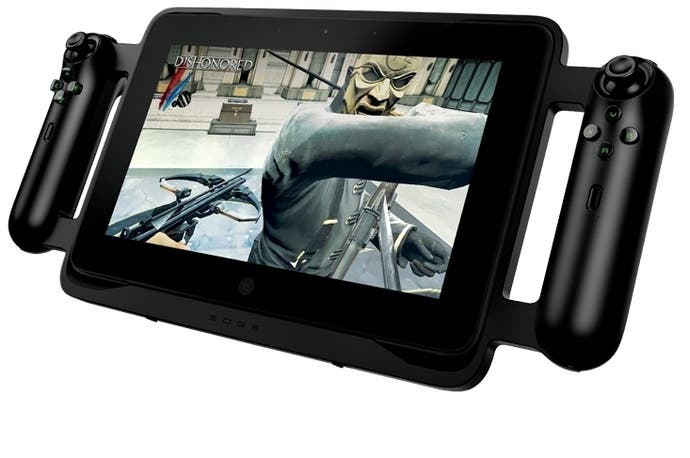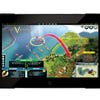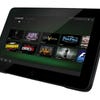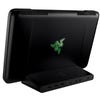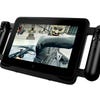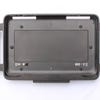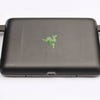Razer Edge review
Crysis 3 on a 10-inch tablet. Believe it.
Your expectations of cutting-edge portable gaming are about to be challenged. With the US launch of the Razer Edge in March and a UK release pending for later this year, we have a device that dares to declare itself all things to all users. On first glance the Edge presents itself as a conventional black-bezeled tablet with a 10.1-inch IPS screen - nothing out of the ordinary, though perhaps a bit over-bulked for the purposes of web browsing and a spot of Angry Birds HD. However, that's because the Edge first and foremost strives to be the most powerful gaming handheld in the market, and it's safe to say that it makes good on that pledge. Crysis 3 on the move? No problem.
With a discrete Nvidia GT 640M LE GPU, the graphical horsepower of this device is absolutely unprecedented in the tablet space. It's a full-on 28nm Kepler chip with support for PhysX, too, which sets it a league apart from the performance of the Intel HD 4000 found in Microsoft's current pack-leader, the Surface Pro.
Processor-wise, we're looking at Intel's ultra-low voltage Ivy Bridge processors. At $999 the cheapest edition comes equipped with a Core i5 CPU clocked at 1.6GHz, while the Pro edition we have for review boasts a Core i7, with its two cores running at 1.9GHz apiece. At its most expensive, the tablet also comes installed with a 256GB SSD, where this higher-tier unit is setting US buyers back by as much as $1499 - obviously not an impulse buy, then. Although Razer is reticent to disclose an official UK price at the moment, this is always destined to convert to a daunting minus number on your credit card bill.
It's just as well that the raison d'etre of the Edge is as ambitious as its specs. Rather than running on Microsoft's Windows RT kernel (designed for ARM-based tablets), the Intel x64 architecture of the device means it can run a full-fat version of Windows 8, making it open season for all of the Steam games in your existing library. The control methods are geared towards the enthusiast gamer crowd also. Whether you go with touch controls, a wired 360 pad or Razer's optional gamepad accessory, the device takes every measure to make playing the most demanding PC games on the go possible at circa 30FPS.
This goes all the way up to DirectX 11 behemoths like Metro: Last Light or Crysis 3. As we're sure you can imagine, such an intense graphical workout comes with some caveats when it comes to heat, noise and battery life - but more on this point later. First up, let's take a look at the tablet design itself.
Build quality and design
On the face of it, the casing and build of the Razer Edge Pro is typical of most tablets, but a glance at its width does reveal it to be a chunkier beast than even the Surface Pro. At 19.5mm deep and 962 grams in weight, it's over double the 8.9mm width of a conventional tablet like the Nexus 10, and a good deal heftier than the Google tablet's 603g return on the scales. Yet put to the standard of ultrabook form factors, it remains an astonishing achievement in build quality. It's undoubtedly the largest tablet of its kind, yet it remains a remarkably small piece of kit overall given the component list and range of ports it offers.
Looking at inputs, on the bottom of the device is a single 40-pin connector for charging, with divots for connectivity to accessories. Elsewhere, at the top edge is a single green USB 3.0 port, a headphone input, volume rocker, plus dedicated buttons farther along for activating a virtual keyboard, and locking screen rotation. The availability of a physical button for the keyboard is welcome, since the OS doesn't always bring a virtual keyboard up after tapping search bars, or during games which require it only briefly. Having a screen-rotation lock is also a smart move for a game-centric device, given how accidentally switching to vertically orientated resolutions rarely goes down well with most FPSs.
Embellishments are few and far between, but Razer does try to inject some character via its signature green, serpentine logo on the back panel, plus a green LED-equipped power button to indicate the status of a recharge. Despite the issues with weight, the matte texturing on the back makes it feasible to hold single-handed, albeit for only short periods. Meanwhile, the glossy coating of the Razer Edge's front panel will be divisive, since fingerprints and sun glare are brought out more vividly than most tablets we've tried. Even on its maximum brightness setting, outdoor use suffers for the screen's reflectiveness - a problem that's evident in some of our photos.
Taken indoors, the Edge's screen outperforms the Nexus 10 in terms of viewing angles, and provides a colourful, adequately bright image - though its lower 1366x768 resolution means we're working with just 155 pixels per inch (ppi). This makes desktop navigation a notably rougher-looking experience than the Nexus 10's crystal-clear 2560x1600 screen. However, it does mean the tablet can easily play games at its fixed native resolution, avoiding any need to upscale and blur the image. The aural side of the gaming experience is also well adjusted for the device: stereo speakers are placed on the bottom rim, producing little distortion on treble even when the volume is cranked up to maximum.
Unlike most tablets, by necessity this device comes installed with an active cooling system. Heat is diffused through two large grilled vents on the unit's top edge, with a single fan passing air through the chassis to keep a constant check on temperature. The resulting whirr fluctuates in intensity, but tends to still be loud and distracting during simple desktop use - and the numbers explain why. Based on sensor-monitoring tests, the Edge's CPU idles at 60 degrees celsius, and the Metro: Last Light benchmark taking that figure up to a scorching 84 degrees. This is a scary statistic, and we suspect that this makes the thermal design power (TDP) of the CPU too tenuous to fully take advantage of its boost function, which can in theory go up to 3GHz.
"Based on sensor-monitoring tests, the Edge's CPU idles at 60 degrees celsius, and the Metro: Last Light benchmark taking that figure up to a scorching 84 degrees."
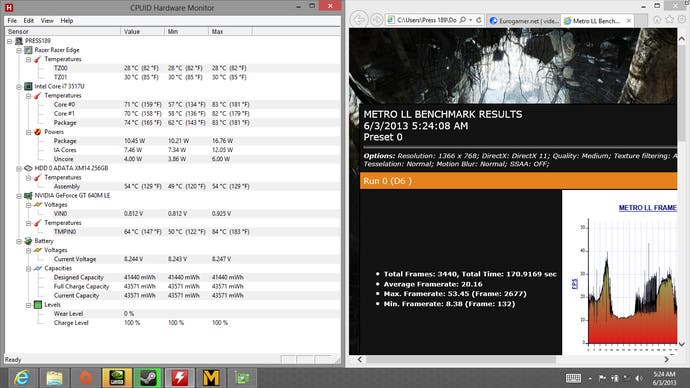
Razer Edge: the accessories
The touch-screen tablet only supports a limited range of games on its own, however, and presuming you're not content with launching birds and chopping fruit, you'll need some accessories to take advantage of the device's gaming capabilities. Certainly, there's touch-screen support built in for Civilization 5 - which happens to be a rare breed of compatible titles - but this control method is insufficient for just about any other game type you might have on your Steam list.
The cheap option is to just plug in a 360 controller, but the question is, where do you then balance the tablet, besides your lap? Opening up options, a docking station is available for the Edge, which also adds a HDMI v1.4 output, three USB 2.0 sockets, headphone and microphone inputs, plus a pass-through for the charger connector. With keyboard and mouse plugged in here it feels just like a PC gaming station - and beneath a HDTV can work smoothly in tandem with plugged-in 360 controllers. The only downside to the device is that it'll set you back another $100 - and given its crucial functionality, it arguably deserves to be included in the package by default.
Positioning the tablet into the dock can be tricky, however, forcing us to use the Windows home button to centralise the slab before sinking it down. Once you make the connection though, it's a pleasure to see everything switch over automatically as you'd hope: the HDMI output kicks in to your HDTV, and any connected USB devices instantly come alive. Razer's launcher front-end program further streamlines this by letting you swipe through your game collection via a tile grid, and also adds icons besides each to show which titles are optimised for the gamepad. It's inoffensive for what is essentially pre-installed bloatware, and offers a touch-enabled interface which Steam's Big Picture mode doesn't cater to. If there is a downside, it's that it takes too long to load on a fresh Windows start-up, and arrests the use of any other programs until it's logged you in.
"The Edge's accessories are beautifully designed and essential to get the most out of the tablet, but the additional costs for the extra kit soon stack up to an alarming level."
If the aim is to use the Edge as a media PC or Steambox, this ranks as a very effective method with few return trips to the tablet to readjust. At its current price though, there are more cost efficient ways of achieving this end, and it belies the focus on portability for which the tablet is actually being advertised. This is where Razer's gamepad controller accessory comes in, which enables what is dubbed the "portable console mode". Astonishingly, the peripheral sets you back around $250, but fulfils the promised vision of integrating a control system with the tablet's core processing tech. This is made possible by means of a rigid matte-plastic chassis, which holds the tablet between two divided controller units - the feel of which being identical to a 360 pad with all the equivalent buttons, plus rumble supported on each side.
All the usual inputs are included: there's a backlit d-pad and four face buttons, recessed start and select buttons, two analogue sticks, four shoulder buttons, and an extra two fully analogue triggers. Build quality and girth of the controller segments call to mind the ergonomics of the PlayStation Move wand, though 360 players will feel right at home with the slightly stiffer travel of the sticks. The only surprise is the design of the d-pad, which allows for individual depression of each button, rather than using a single mould which allows for clearer rolling motions for fighting games. Even so, the commitment to quality holds up to the standards of Razer's Sabertooth controller.
Without the need for a mouse and keyboard, in this state the tablet can be taken away from the desk and be treated like an over-sized portable Vita or 3DS. This control method does exacerbate a previous issue though: the weight. At a starting point of 962g, once the tablet is locked into the gamepad it falls closer to the 1.9kg mark, which is a bit of a wear on the wrists for long stretches - making it lap-bound for most gaming sessions.
An external battery pack rounds off the list of extras available for the device. This extra pack embeds itself in the gamepad accessory, and in large part it is necessary to offset the power draw of the controller's rumble and backlit buttons. It also compensates for the likelier use of the GT640M LE while in this mode, where the fan ratchets up to near-turbulent speeds while playing visually intensive games outside of the home. This is where the Razer Edge's proposed "console gaming on the go" mantra falls apart. Just as the gamepad is essential for making the Edge convenient to control during a commute, the extra battery is crucial for actually keeping it powered for any respectable length of time. It's a shock, then, to find that this incurs a further $69.
"The 2MP front camera is good enough for video calls but little else - Razer has avoided the temptation to put an additional camera on the rear of the unit."

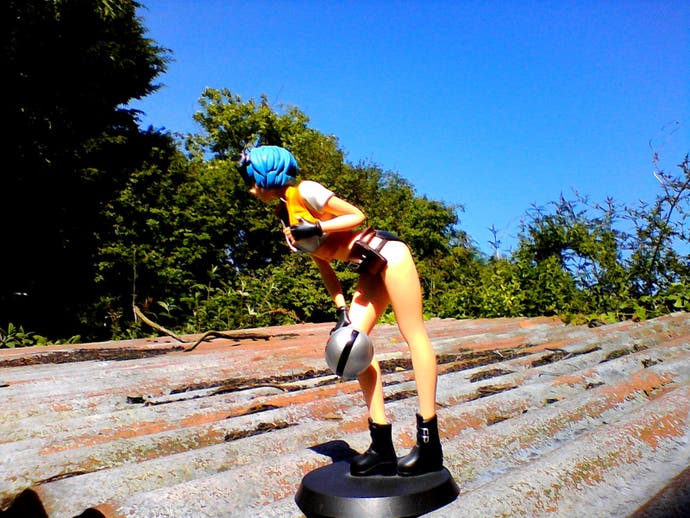


The battery life stats of the Edge are sobering. Put into perspective, the Edge's integrated battery is rated at a respectable 5600mAh, but for touch-based games like Civilization V this can only muster one hour, 20 minutes off the battery. This is with the highest brightness setting needed for outdoors play, volume set to 50 per cent and the power management mode set to maximum performance. When put to more general use, such as web browsing and video viewing, this figure raises to three hours, ten minutes. Given that desktop use purely runs off the more power-efficient Intel HD 4000, with Nvidia Optimus switching off its discrete GPU, this figure is still pretty dire.
The gamepad in conjunction with the extra battery pack sets to solve this. However, under the very same settings during intense gaming in Metro: Last Light, battery life is barely increased to one hour, 40 minutes. As a silver lining, recharging the standard and optional batteries is a simultaneous process, and takes one hour, 50 minutes - just a few minutes more than charging the Edge on its own. All in all, it's still a disappointment given all the financial expenditure it takes to get to this point, but these times do fall in line with the expectations of just about any ultrabook during similar gaming-based tasks - and they won't have the Nvidia graphics chip.
Performance analysis
Playing purely off the mains, the Edge is still quite the performer. Due in no small part to the OS being installed to a 256GB SSD, we can cold boot straight to desktop in just under eight seconds. The going logic with tablets is that once they're on, they tend to stay active for weeks at a time - though this puts the speed of the Razer Edge in favourable light compared to the 18-second boot for our Apple iPad 4, or the 29 seconds it takes to load the Nexus 10.
| Razer Edge Pro | iPad 4 | Nexus 10 | |
|---|---|---|---|
| Sunspider 0.9.1 (Java) | 149.1ms | 840.8ms | 873.3ms |
| Kraken 1.1 (Java) | 6383.7ms | 16699.9ms | 7930.5ms |
| GLBenchmark 2.7 T-Rex HD (offscreen) | 55FPS | 16FPS | 12FPS |
| GLBenchmark 2.7 Egypt HD (offscreen) | 130FPS | 50FPS | 39FPS |
| Fill-Rate (offscreen) | 5.822 gigatexels/s | 2.044 gigatexels/s | 1.332 gigatexels/s |
| Triangle throughput: textured/fragment lit (offscreen) | 373.6 million tris/s | 113.5 million tris/s | 35.7 million tris/s |
A comparison of web-browsing speeds shows a similar chasm in response for our Java-based tests. With Google Chrome installed, the Nexus 10 gets the closest to the Edge's Internet Explorer 10 results in Kraken 1.1 - a latency benchmarking tool that sees the browser download and upload a sequence of large files. However, when it comes to gauging the theoretical advantage the Edge has in 3D rendering over its tablet competition, the difference is best measured with the GFX GLBenchmark app.
This tool is available for free on each device's respective store and has the Nexus 10, iPad 4 and Razer Edge tasked with calculating stunning environments. The first is centred around a battle with sphinxes in an Egyptian temple, while the more recent 2.7 version takes us on motorbike ride through a jungle as we escape a T-Rex. The latter is complete with more complex effects-work, such as motion blur, and heavier use of parallax mapping and of particle effects. More synthetic tests are also included, measuring off-screen texel and triangle throughputs per second.
Equipped with a Core i7 processor and Nvidia 640M, this is an expected whipping when compared to the quad-core PowerVR SGX554MP4 seen in the iPad 4. For off-screen tests, the Edge shows up with a lead of around 340 pre cent over Apple's tablet in the more taxing Rex HD benchmark, while the Nexus 10's Mali T-604 GPU consistently trails behind. This is borne out with the fragment lit triangle tests too, and the cascade here proves even less flattering for Google's flagship 10-incher, which manages barely 10 per cent of the Edge's throughput of 373.6 million triangles per second.
Comparisons with other handheld devices are perhaps unfair given the Edge's vastly higher price-point. For the sake of giving the device a better run for its money, we take the current holy trinity of FPS titles - Metro: Last Light, Crysis 3 and Battlefield 3 - and see how far each can be pushed visually before the 30FPS target is challenged. Before beginning our capture tests, we update the Nvidia drivers to version 320.18, and make sure each game outputs at the tablet's native 1366x768 resolution.
To kick off with the most rigorous stress test of the three, Crysis 3 forces DirectX 11 API features on even the lowest settings, with parallax occlusion mapping enabled across the board. As a result, drops to 20FPS are a common sensation on the medium preset during the rainy Post-Human stage, which is where we have to make the biggest sacrifices. Opting for the lowest common preset is the only way forward, alongside low-resolution textures, and FXAA. In the end, this gives us the most level response from one level to the next, and 30FPS holds up for even the jungle stages.
Metro: Last Light, meanwhile, fares much better for sticking to a more linear design. The game's cavernous, indoor environments are richly detailed with some of the most detailed textures we've seen in a shooter. Razer's Edge pulls of medium settings with ease, and in conjunction with normal motion blur and FXAA hits between 30-40FPS. As a preventative measure, tessellation is turned off to avoid choppy playback when walking through the crowds in Bolshoi or Reich levels. Similarly, no advanced PhysX settings are possible at an acceptable frame-rate, though the default physics model still impresses with chip damage to walls.
DICE's Battlefield 3 is still going strong as the most open-ended shooter experience of the three, and again we can qualify for the medium and easily fix on 30FPS - double the rate compared to the game running on Intel's HD 4000. The only issue we have with the game is when using the gamepad accessory. Unfortunately, the button prompts don't adapt as they would with a 360 pad, meaning quick-time events demand a reach for a nearby keyboard. The "Going Hunting" level's cockpit tests had us tapping every button on the controller in order to resolve this - and it's only by process of trial and error that we forced our way through that section. BF3's pad support isn't particularly robust.
"The GPU is well suited for 1366x768 native-res tablet gameplay. Attached to an HDTV, the Edge doesn't have the horsepower for satisfying 1080p action."
Alternative analysis:
To see how titles hold up on the device in controlled sequences, we run the game benchmarks included in the likes of Tomb Raider, BioShock Infinite and Sleeping Dogs. The idea is to target medium settings in every case, with no v-sync enabled (in order to run the GPU fully unlocked), and DX11 features such as tessellation. FXAA is enabled where possible to save on the graphics chip's bandwidth, though we resort to 2x MSAA where this isn't possible, in order to clear up the image.
All things considered, the decision to vie for a 768p native screen resolution is vindicated here. When comparing the two resolution outputs, the capabilities of the GT 640M LE are simply stretched too far when it comes to playing at full 1080p HD. The exceptions to this rule are Sleeping Dogs and Dirt: Showdown - both of which sustain 30FPS - but making other games playable at this setting involves a reduction to the very lowest settings.
| Razer Edge Pro 768p | Razer Edge Pro 1080p | |
|---|---|---|
| BioShock Infinite | 40.6FPS | 23.6FPS |
| Hitman: Absolution | 28.8FPS | 18.4FPS |
| DiRT: Showdown | 63.1FPS | 36.5FPS |
| Metro: Last Light | 20.3FPS | 13.3FPS |
| Sleeping Dogs | 57.0FPS | 31.7FPS |
| Tomb Raider | 35.3FPS | 22.4FPS |
| Crysis | 33.1FPS | 18.0FPS |
This indelibly proves the Razer Edge's credentials as a competent gaming machine. Even the original Crysis plays out its benchmarking tour at a playable frame-rate, which highlights the virtues of the tablet's hefty i7 processor for handling physics-based tasks. The only issue here is the lack of true competition among its tablet brethren, as both the technical make-up and gaming results fall within the boundaries of ultrabooks equipped with similar Nvidia chips
One device that makes for a tighter match is the Acer Ultra M3, a 15.6-inch gaming laptop we've previously taken to task. During its comparison with the far pricier Alienware M14x alternative, the take-away was that the Acer acquitted itself far better when considering the performance-per-pound. Indeed, since then the model has gone down in price, and for just over £650 it's possible to grab a model with a matching Core i7-3517U processor. Downscale to an i5 and that price falls to just £500. This also comes complete with a faster version of the Edge's GPU - the standard Nvidia GT 640M which factors in a higher 625MHz core clock, though there is just 1GB of dedicated RAM - the same as the standard Edge, but 1GB less than the Pro.
Even so, put side by side with our less capable i5-2467M version of the Ultra M3, the 3D Mark 11 results below show there are cheaper alternatives which can push out more impressive results if the tablet form factor can be replaced by a laptop with a standard gamepad attached. The only shortcoming during these synthetic tests is in the physics departments, explained by the shortfall in CPU power on our Acer ultrabook review subject.
"The build quality and outright graphical grunt of the Razer Edge manages to drop jaws. Construction is sturdy, and the visual quality oozing from its IPS screen is beautiful..."
| Razer Edge Pro (Performance) | Acer Ultra M3 (Performance) | Razer Edge Pro (Extreme) | Acer Ultra M3 (Extreme) | |
|---|---|---|---|---|
| 3DMark | P1518 | P1819 | X521 | X591 |
| Graphics: | 1458 | 1748 | 462 | 531 |
| Physics | 1292 | 1506 | 3730 | 2748 |
| Combined | 1292 | 1506 | 597 | 679 |
Razer Edge Pro - the Digital Foundry verdict
The Razer Edge Pro is a device designed to impress any gadget aficionado and earns major kudos for doing something which no other tablet does. It's the only portable of its kind to sport a dedicated graphics solution from Nvidia, while packing in all the usual bells and whistles of a touch-screen tablet device. The biggest let-down is undoubtedly the price of entry to turn the device into a portable gaming machine, and the sub two-hour window we have to experience Metro: Last Light on the go before the battery flat-lines.
After factoring in the cost of the extra gamepad extension and additional battery pack to make this happen, the sum leans closer to the $2000 mark. Once we factor in these essential additions, we're looking at a budget that could cover the costs of a better-rounded, more energy-efficient 10.1-inch tablet such as the Nexus 10 and also a more powerful gaming laptop. The excess you'd pay for the Razer Edge simply accounts for the convenience of having everything in one gadget.
Overlooking the noisiness of its fan-cooled innards, the actual build quality and outright graphical grunt of this Pro unit still manages to drop jaws. Its construction is sturdy, and the visual quality oozing from its IPS screen is beautiful. However, the price paid here is in the cumbersome weight of the device, which doubles once the gamepad extension is added. A jack of all trades but a master of none, it's not as comfortable to hold as most other tablets, nor is it powerful enough to stand up to gaming grade PCs at the same price.
However, the fact of the matter is no other company has had the guts to give such a madcap idea a spin, revealing to the world the triumphs and pitfalls of such a device in action. In the future we could see a slew of copycat gaming tablets encroaching on the market, each approaching the same concept with the intention of making it cheaper or lighter. But as it stands, Razer deserves full credit for being first to a party which may or may not start.
